MCP23017 I/O Expander: Datasheet, pinout and Addressing
28 Termination 2.54mm 5V I/O Expander MCP23017 28 Pin 5V 28-DIP (0.300, 7.62mm)









28 Termination 2.54mm 5V I/O Expander MCP23017 28 Pin 5V 28-DIP (0.300, 7.62mm)
MCP23017 is a 16-bit I/O expander with a serial interface. This article mainly covers datasheet, pinout, features, and other details about MCP23017.

How to connect the MCP23017 GPIO Expander to an Arduino and Raspberry Pi
MCP23017 Pinout

MCP23017 Pinout
MCP23017 CAD Model
Symbol

Symbol
Footprint
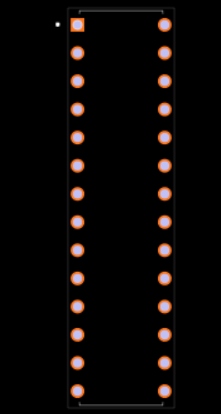
Footprint
3D Model
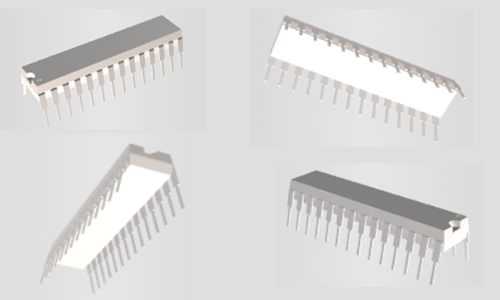
3D Model
Overview of MCP23017
The MCP23017 is a port expander that gives you virtually identical PORTS compared to standard microcontrollers e.g. Arduino or PIC devices and it even includes interrupts. It gives you an extra 16 I/O pins using an I2C interface as well as comprehensive interrupt control.
MCP23017 Block Diagram
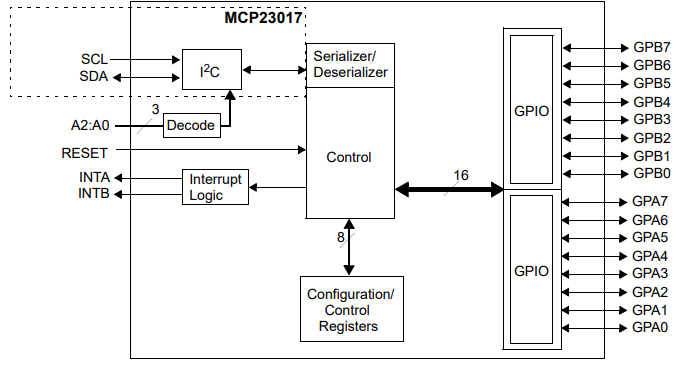
MCP23017 Block Diagram
MCP23017 Features
•16-Bit Remote Bidirectional I/O Port:
- I/O pins default to input
• High-Speed I2C Interface (MCP23017):
- 100 kHz
- 400 kHz
- 1.7 MHz
• High-Speed SPI Interface (MCP23S17):
- 10 MHz (maximum)
• Three Hardware Address Pins to Allow Up to
Eight Devices on the Bus
• Configurable Interrupt Output Pins:
- Configurable as active-high, active-low or
open-drain
• INTA and INTB Can Be Configured to Operate
Independently or Together
• Configurable Interrupt Source:
- Interrupt-on-change from configured register defaults or pin changes
• Polarity Inversion Register to Configure the
Polarity of the Input Port Data
• External Reset Input
• Low Standby Current: 1 µA (max.)
• Operating Voltage:
- 1.8V to 5.5V @ -40°C to +85°C
- 2.7V to 5.5V @ -40°C to +85°C
- 4.5V to 5.5V @ -40°C to +125°C
Specifications
- TypeParameter
- Factory Lead Time12 Weeks
- Mount
In electronic components, the term "Mount" typically refers to the method or process of physically attaching or fixing a component onto a circuit board or other electronic device. This can involve soldering, adhesive bonding, or other techniques to secure the component in place. The mounting process is crucial for ensuring proper electrical connections and mechanical stability within the electronic system. Different components may have specific mounting requirements based on their size, shape, and function, and manufacturers provide guidelines for proper mounting procedures to ensure optimal performance and reliability of the electronic device.
Surface Mount, Through Hole - Mounting Type
The "Mounting Type" in electronic components refers to the method used to attach or connect a component to a circuit board or other substrate, such as through-hole, surface-mount, or panel mount.
Through Hole - Package / Case
refers to the protective housing that encases an electronic component, providing mechanical support, electrical connections, and thermal management.
28-DIP (0.300, 7.62mm) - Number of Pins28
- Number of I/Os16
- Operating Temperature
The operating temperature is the range of ambient temperature within which a power supply, or any other electrical equipment, operate in. This ranges from a minimum operating temperature, to a peak or maximum operating temperature, outside which, the power supply may fail.
-40°C~125°C - Packaging
Semiconductor package is a carrier / shell used to contain and cover one or more semiconductor components or integrated circuits. The material of the shell can be metal, plastic, glass or ceramic.
Tube - Published2006
- JESD-609 Code
The "JESD-609 Code" in electronic components refers to a standardized marking code that indicates the lead-free solder composition and finish of electronic components for compliance with environmental regulations.
e3 - Pbfree Code
The "Pbfree Code" parameter in electronic components refers to the code or marking used to indicate that the component is lead-free. Lead (Pb) is a toxic substance that has been widely used in electronic components for many years, but due to environmental concerns, there has been a shift towards lead-free alternatives. The Pbfree Code helps manufacturers and users easily identify components that do not contain lead, ensuring compliance with regulations and promoting environmentally friendly practices. It is important to pay attention to the Pbfree Code when selecting electronic components to ensure they meet the necessary requirements for lead-free applications.
yes - Part Status
Parts can have many statuses as they progress through the configuration, analysis, review, and approval stages.
Active - Moisture Sensitivity Level (MSL)
Moisture Sensitivity Level (MSL) is a standardized rating that indicates the susceptibility of electronic components, particularly semiconductors, to moisture-induced damage during storage and the soldering process, defining the allowable exposure time to ambient conditions before they require special handling or baking to prevent failures
1 (Unlimited) - Number of Terminations28
- ECCN Code
An ECCN (Export Control Classification Number) is an alphanumeric code used by the U.S. Bureau of Industry and Security to identify and categorize electronic components and other dual-use items that may require an export license based on their technical characteristics and potential for military use.
EAR99 - Terminal Finish
Terminal Finish refers to the surface treatment applied to the terminals or leads of electronic components to enhance their performance and longevity. It can improve solderability, corrosion resistance, and overall reliability of the connection in electronic assemblies. Common finishes include nickel, gold, and tin, each possessing distinct properties suitable for various applications. The choice of terminal finish can significantly impact the durability and effectiveness of electronic devices.
Matte Tin (Sn) - Voltage - Supply
Voltage - Supply refers to the range of voltage levels that an electronic component or circuit is designed to operate with. It indicates the minimum and maximum supply voltage that can be applied for the device to function properly. Providing supply voltages outside this range can lead to malfunction, damage, or reduced performance. This parameter is critical for ensuring compatibility between different components in a circuit.
1.8V~5.5V - Terminal Position
In electronic components, the term "Terminal Position" refers to the physical location of the connection points on the component where external electrical connections can be made. These connection points, known as terminals, are typically used to attach wires, leads, or other components to the main body of the electronic component. The terminal position is important for ensuring proper connectivity and functionality of the component within a circuit. It is often specified in technical datasheets or component specifications to help designers and engineers understand how to properly integrate the component into their circuit designs.
DUAL - Peak Reflow Temperature (Cel)
Peak Reflow Temperature (Cel) is a parameter that specifies the maximum temperature at which an electronic component can be exposed during the reflow soldering process. Reflow soldering is a common method used to attach electronic components to a circuit board. The Peak Reflow Temperature is crucial because it ensures that the component is not damaged or degraded during the soldering process. Exceeding the specified Peak Reflow Temperature can lead to issues such as component failure, reduced performance, or even permanent damage to the component. It is important for manufacturers and assemblers to adhere to the recommended Peak Reflow Temperature to ensure the reliability and functionality of the electronic components.
NOT APPLICABLE - Supply Voltage
Supply voltage refers to the electrical potential difference provided to an electronic component or circuit. It is crucial for the proper operation of devices, as it powers their functions and determines performance characteristics. The supply voltage must be within specified limits to ensure reliability and prevent damage to components. Different electronic devices have specific supply voltage requirements, which can vary widely depending on their design and intended application.
5V - Terminal Pitch
The center distance from one pole to the next.
2.54mm - Time@Peak Reflow Temperature-Max (s)
Time@Peak Reflow Temperature-Max (s) refers to the maximum duration that an electronic component can be exposed to the peak reflow temperature during the soldering process, which is crucial for ensuring reliable solder joint formation without damaging the component.
NOT APPLICABLE - Base Part Number
The "Base Part Number" (BPN) in electronic components serves a similar purpose to the "Base Product Number." It refers to the primary identifier for a component that captures the essential characteristics shared by a group of similar components. The BPN provides a fundamental way to reference a family or series of components without specifying all the variations and specific details.
MCP23017 - Pin Count
a count of all of the component leads (or pins)
28 - Qualification Status
An indicator of formal certification of qualifications.
Not Qualified - Output Type
The "Output Type" parameter in electronic components refers to the type of signal or data that is produced by the component as an output. This parameter specifies the nature of the output signal, such as analog or digital, and can also include details about the voltage levels, current levels, frequency, and other characteristics of the output signal. Understanding the output type of a component is crucial for ensuring compatibility with other components in a circuit or system, as well as for determining how the output signal can be utilized or processed further. In summary, the output type parameter provides essential information about the nature of the signal that is generated by the electronic component as its output.
Push-Pull - Power Supplies
an electronic circuit that converts the voltage of an alternating current (AC) into a direct current (DC) voltage.?
5V - Number of Channels1
- Interface
In electronic components, the term "Interface" refers to the point at which two different systems, devices, or components connect and interact with each other. It can involve physical connections such as ports, connectors, or cables, as well as communication protocols and standards that facilitate the exchange of data or signals between the connected entities. The interface serves as a bridge that enables seamless communication and interoperability between different parts of a system or between different systems altogether. Designing a reliable and efficient interface is crucial in ensuring proper functionality and performance of electronic components and systems.
I2C - Number of Ports
A port is identified for each transport protocol and address combination by a 16-bit unsigned number,.
2 - Nominal Supply Current
Nominal current is the same as the rated current. It is the current drawn by the motor while delivering rated mechanical output at its shaft.
1mA - Number of Bits16
- Clock Frequency
Clock frequency, also known as clock speed, refers to the rate at which a processor or electronic component can execute instructions. It is measured in hertz (Hz) and represents the number of cycles per second that the component can perform. A higher clock frequency typically indicates a faster processing speed and better performance. However, it is important to note that other factors such as architecture, efficiency, and workload also play a significant role in determining the overall performance of a component. In summary, clock frequency is a crucial parameter that influences the speed and efficiency of electronic components in processing data and executing tasks.
1.7MHz - Interrupt Output
In electronic components, "Interrupt Output" refers to a feature that allows a device to signal the occurrence of a specific event or condition that requires immediate attention from the system or user. When the specified event occurs, the interrupt output generates a signal to pause the normal operation of the device and divert the attention to handle the urgent task. This feature is commonly used in microcontrollers, processors, and other integrated circuits to efficiently manage tasks and prioritize critical operations. By utilizing interrupt outputs, electronic systems can respond promptly to important events, improve overall performance, and enhance real-time responsiveness.
Yes - Current - Output Source/Sink
The parameter "Current - Output Source/Sink" in electronic components refers to the maximum amount of current that the component can either source (provide) or sink (absorb) at its output pin. This parameter is crucial in determining the capability of the component to drive external loads such as other components or devices. The source current indicates the maximum current that the component can supply to the load, while the sink current indicates the maximum current that the component can draw from the load. Understanding this parameter is essential for designing circuits that require specific current-handling capabilities to ensure proper functionality and reliability.
25mA - Features
In the context of electronic components, the term "Features" typically refers to the specific characteristics or functionalities that a particular component offers. These features can vary depending on the type of component and its intended use. For example, a microcontroller may have features such as built-in memory, analog-to-digital converters, and communication interfaces like UART or SPI.When evaluating electronic components, understanding their features is crucial in determining whether they meet the requirements of a particular project or application. Engineers and designers often look at features such as operating voltage, speed, power consumption, and communication protocols to ensure compatibility and optimal performance.In summary, the "Features" parameter in electronic components describes the unique attributes and capabilities that differentiate one component from another, helping users make informed decisions when selecting components for their electronic designs.
POR - Height Seated (Max)
Height Seated (Max) is a parameter in electronic components that refers to the maximum allowable height of the component when it is properly seated or installed on a circuit board or within an enclosure. This specification is crucial for ensuring proper fit and alignment within the overall system design. Exceeding the maximum seated height can lead to mechanical interference, electrical shorts, or other issues that may impact the performance and reliability of the electronic device. Manufacturers provide this information to help designers and engineers select components that will fit within the designated space and function correctly in the intended application.
5.08mm - Width7.62mm
- REACH SVHC
The parameter "REACH SVHC" in electronic components refers to the compliance with the Registration, Evaluation, Authorization, and Restriction of Chemicals (REACH) regulation regarding Substances of Very High Concern (SVHC). SVHCs are substances that may have serious effects on human health or the environment, and their use is regulated under REACH to ensure their safe handling and minimize their impact.Manufacturers of electronic components need to declare if their products contain any SVHCs above a certain threshold concentration and provide information on the safe use of these substances. This information allows customers to make informed decisions about the potential risks associated with using the components and take appropriate measures to mitigate any hazards.Ensuring compliance with REACH SVHC requirements is essential for electronics manufacturers to meet regulatory standards, protect human health and the environment, and maintain transparency in their supply chain. It also demonstrates a commitment to sustainability and responsible manufacturing practices in the electronics industry.
No SVHC - RoHS Status
RoHS means “Restriction of Certain Hazardous Substances” in the “Hazardous Substances Directive” in electrical and electronic equipment.
ROHS3 Compliant - Lead Free
Lead Free is a term used to describe electronic components that do not contain lead as part of their composition. Lead is a toxic material that can have harmful effects on human health and the environment, so the electronics industry has been moving towards lead-free components to reduce these risks. Lead-free components are typically made using alternative materials such as silver, copper, and tin. Manufacturers must comply with regulations such as the Restriction of Hazardous Substances (RoHS) directive to ensure that their products are lead-free and environmentally friendly.
Lead Free
MCP23017 Circuit
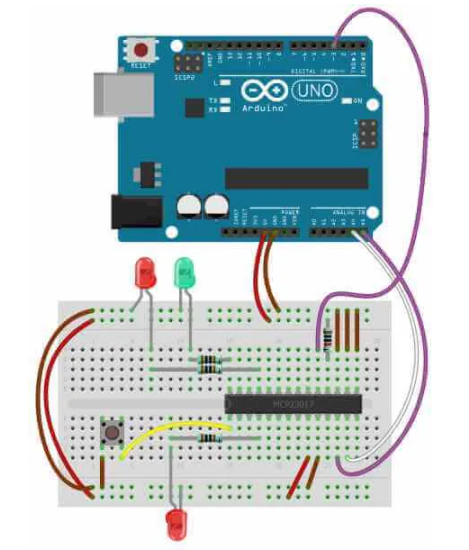
MCP23017 Circuit
How to use MCP23017
To power, the MCP23017, connects the VDD pin to the +5V voltage rail, and the VSS pin to the ground rail. Connect the SCL and SDA pins on the MCP23017 to the I2C pins on the Raspberry Pi hardware. Set the I2C device address of the MCP23017 to '0x20' by grounding the A0, A1, A2 pins.
MCP23017 Addressing
The MCP23017 I2C address range is 32 decimal to 37 decimal or 0x20 to 0x27 for the MCP23017. Note: The address range allows 3 bits and this means a maximum of eight MCP23017 devices can be attached to any single I2C bus.
MCP23017 Package
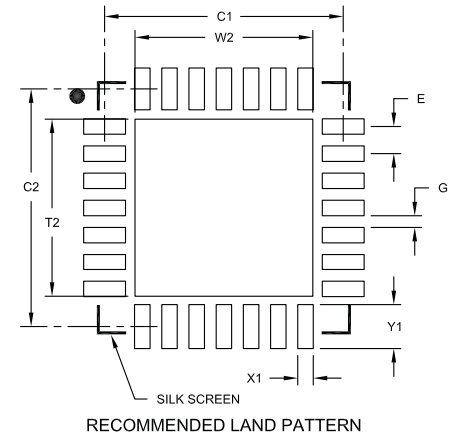
MCP23017 Package
MCP23017 Manufacturer
Microchip Technology Inc. is a leading provider of microcontroller and analog semiconductors, providing low-risk product development, lower total system cost, and faster time to market for thousands of diverse customer applications worldwide. Headquartered in Chandler, Arizona, Microchip offers outstanding technical support along with dependable delivery and quality.
Parts with Similar Specs
- ImagePart NumberManufacturerPackage / CaseNumber of PinsInterfaceSupply VoltageTechnologyECCN CodeWidthMountView Compare
MCP23017-E/SP
28-DIP (0.300, 7.62mm)
28
I2C
5 V
CMOS
EAR99
7.62 mm
Surface Mount, Through Hole
20-DIP (0.300, 7.62mm)
20
-
5 V
CMOS
EAR99
7.62 mm
Through Hole
28-DIP (0.300, 7.62mm)
28
I2C
5 V
CMOS
EAR99
7.62 mm
Through Hole
28-DIP (0.300, 7.62mm)
28
I2C
5 V
CMOS
EAR99
7.62 mm
Through Hole
Trend Analysis
Parts with Similar Specs
- ImagePart NumberManufacturerPackage / CaseNumber of PinsInterfaceSupply VoltageTechnologyECCN CodeWidthMountView Compare
MCP23017-E/SP
28-DIP (0.300, 7.62mm)
28
I2C
5 V
CMOS
EAR99
7.62 mm
Surface Mount, Through Hole
20-DIP (0.300, 7.62mm)
20
-
5 V
CMOS
EAR99
7.62 mm
Through Hole
28-DIP (0.300, 7.62mm)
28
I2C
5 V
CMOS
EAR99
7.62 mm
Through Hole
28-DIP (0.300, 7.62mm)
28
I2C
5 V
CMOS
EAR99
7.62 mm
Through Hole
How does MCP23017 work?
The MCP23017 is a port expander that gives you virtually identical PORTS compared to standard microcontrollers e.g. Arduino or PIC devices and it even includes interrupts. It gives you an extra 16 I/O pins using an I2C interface as well as comprehensive interrupt control.
How to use MCP23017?
To power, the MCP23017 connects the VDD pin to the +5V voltage rail and the VSS pin to the ground rail. Connect the SCL and SDA pins on the MCP23017 to the I2C pins on the Raspberry Pi hardware. Set the I2C device address of the MCP23017 to '0x20' by grounding the A0, A1, A2 pins.
 LM386 Low Voltage Audio Power Amplifier: Features, Specifications, Applications
LM386 Low Voltage Audio Power Amplifier: Features, Specifications, Applications10 May 20211498
![2CR5 Lithium battery[FAQ+Video]: Equivalents, Datasheet, and 2CR5 vs CR123A](https://res.utmel.com/Images/Article/d457194e-da35-4dca-b816-3e43f317da63.jpg) 2CR5 Lithium battery[FAQ+Video]: Equivalents, Datasheet, and 2CR5 vs CR123A
2CR5 Lithium battery[FAQ+Video]: Equivalents, Datasheet, and 2CR5 vs CR123A20 April 20227865
 BF245 Transistors: Replacement, Pinout and Datasheet
BF245 Transistors: Replacement, Pinout and Datasheet02 September 202114238
 SN74LVC1G08DCKR positive-AND gate: Features, Applications and Datasheet
SN74LVC1G08DCKR positive-AND gate: Features, Applications and Datasheet20 October 2023779
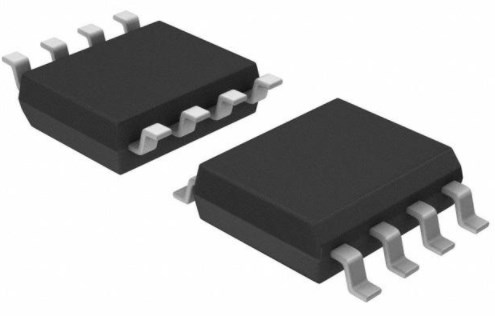 SN65HVD1781DR Transceiver: Circuit, RS-485
SN65HVD1781DR Transceiver: Circuit, RS-48528 March 20221454
 LM111 Differential Comparators: Alternative, Pinout and Datasheet
LM111 Differential Comparators: Alternative, Pinout and Datasheet16 July 20211377
 Best STM32F103VBT6-Compatible Development Boards for 2025
Best STM32F103VBT6-Compatible Development Boards for 202524 July 2025607
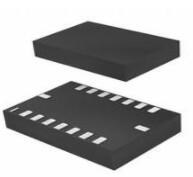 BMI088 IMU: BMI088 Datasheet, Pinout, BMI088 vs. MPU6050
BMI088 IMU: BMI088 Datasheet, Pinout, BMI088 vs. MPU605026 March 20225161
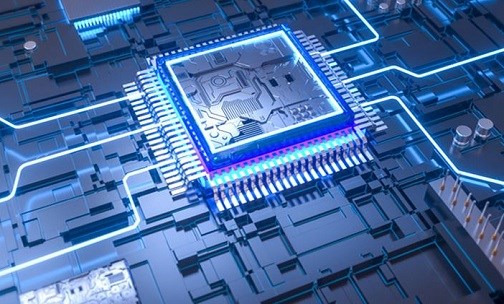 Microcontroller (MCU) Market Analysis
Microcontroller (MCU) Market Analysis09 February 20224066
 How Do We Seize Investment Opportunities on the Eve of the Ultimate Human Energy Final?
How Do We Seize Investment Opportunities on the Eve of the Ultimate Human Energy Final?12 July 2022886
 Near Field Communication (NFC) Explained: Working and Applications
Near Field Communication (NFC) Explained: Working and Applications24 May 202111406
 0 Ohm Resistor Explained
0 Ohm Resistor Explained10 December 202115251
 Semiconductor Inspection System Market Expected to Reach US$ 8,380.01 Million By 2030
Semiconductor Inspection System Market Expected to Reach US$ 8,380.01 Million By 203015 September 20232270
 High-Frequency Silicon Carbide MOSFETs using Resonant Gate Driver Circuits
High-Frequency Silicon Carbide MOSFETs using Resonant Gate Driver Circuits13 March 20241652
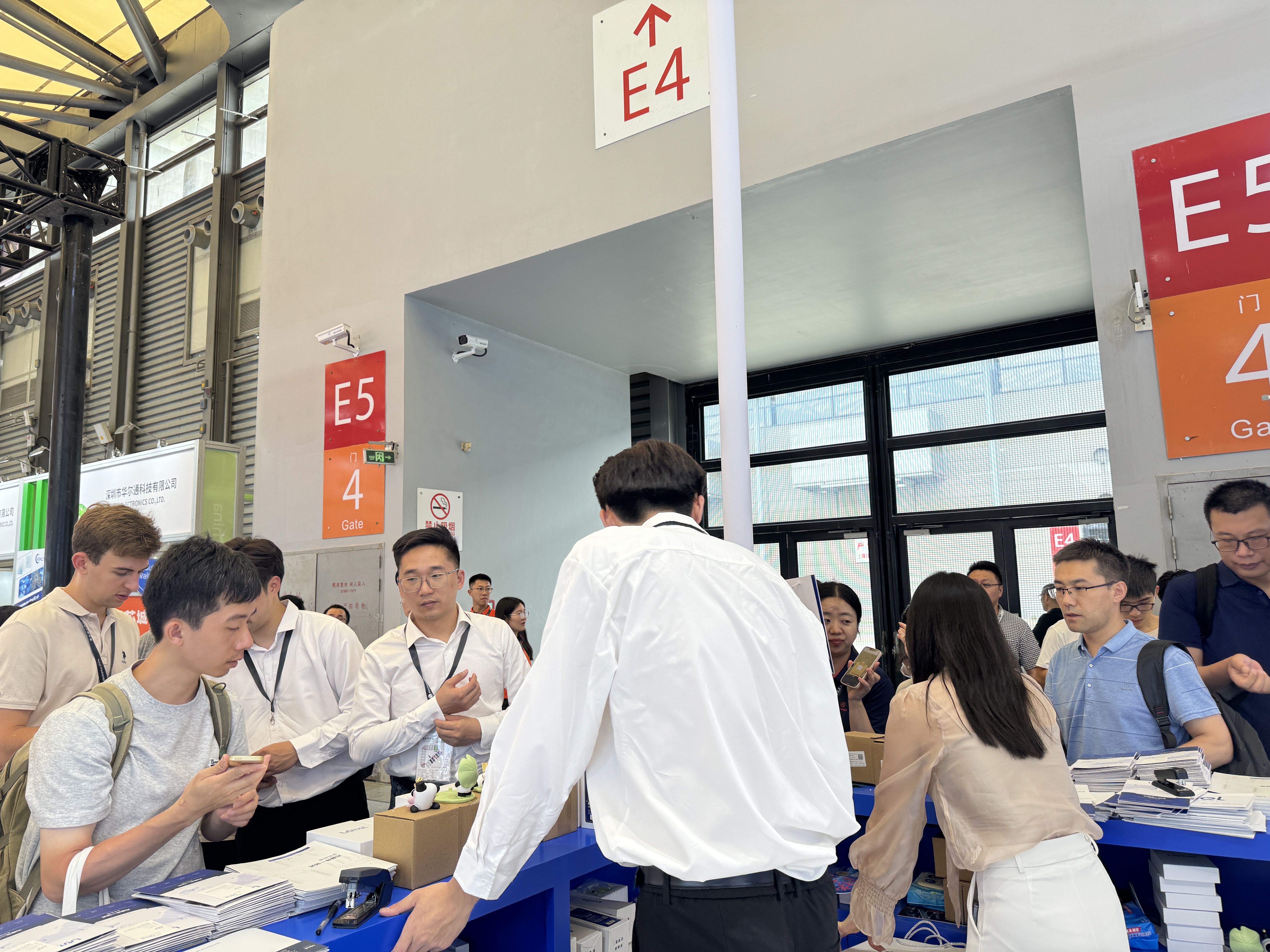 Electronic components distributor UTMEL Stands Out at electronica china 2024
Electronic components distributor UTMEL Stands Out at electronica china 202409 July 20242728
 Electronic components distributor UTMEL to Showcase at electronica China
Electronic components distributor UTMEL to Showcase at electronica China07 June 20242506
Microchip Technology
In Stock: 2250
United States
China
Canada
Japan
Russia
Germany
United Kingdom
Singapore
Italy
Hong Kong(China)
Taiwan(China)
France
Korea
Mexico
Netherlands
Malaysia
Austria
Spain
Switzerland
Poland
Thailand
Vietnam
India
United Arab Emirates
Afghanistan
Åland Islands
Albania
Algeria
American Samoa
Andorra
Angola
Anguilla
Antigua & Barbuda
Argentina
Armenia
Aruba
Australia
Azerbaijan
Bahamas
Bahrain
Bangladesh
Barbados
Belarus
Belgium
Belize
Benin
Bermuda
Bhutan
Bolivia
Bonaire, Sint Eustatius and Saba
Bosnia & Herzegovina
Botswana
Brazil
British Indian Ocean Territory
British Virgin Islands
Brunei
Bulgaria
Burkina Faso
Burundi
Cabo Verde
Cambodia
Cameroon
Cayman Islands
Central African Republic
Chad
Chile
Christmas Island
Cocos (Keeling) Islands
Colombia
Comoros
Congo
Congo (DRC)
Cook Islands
Costa Rica
Côte d’Ivoire
Croatia
Cuba
Curaçao
Cyprus
Czechia
Denmark
Djibouti
Dominica
Dominican Republic
Ecuador
Egypt
El Salvador
Equatorial Guinea
Eritrea
Estonia
Eswatini
Ethiopia
Falkland Islands
Faroe Islands
Fiji
Finland
French Guiana
French Polynesia
Gabon
Gambia
Georgia
Ghana
Gibraltar
Greece
Greenland
Grenada
Guadeloupe
Guam
Guatemala
Guernsey
Guinea
Guinea-Bissau
Guyana
Haiti
Honduras
Hungary
Iceland
Indonesia
Iran
Iraq
Ireland
Isle of Man
Israel
Jamaica
Jersey
Jordan
Kazakhstan
Kenya
Kiribati
Kosovo
Kuwait
Kyrgyzstan
Laos
Latvia
Lebanon
Lesotho
Liberia
Libya
Liechtenstein
Lithuania
Luxembourg
Macao(China)
Madagascar
Malawi
Maldives
Mali
Malta
Marshall Islands
Martinique
Mauritania
Mauritius
Mayotte
Micronesia
Moldova
Monaco
Mongolia
Montenegro
Montserrat
Morocco
Mozambique
Myanmar
Namibia
Nauru
Nepal
New Caledonia
New Zealand
Nicaragua
Niger
Nigeria
Niue
Norfolk Island
North Korea
North Macedonia
Northern Mariana Islands
Norway
Oman
Pakistan
Palau
Palestinian Authority
Panama
Papua New Guinea
Paraguay
Peru
Philippines
Pitcairn Islands
Portugal
Puerto Rico
Qatar
Réunion
Romania
Rwanda
Samoa
San Marino
São Tomé & Príncipe
Saudi Arabia
Senegal
Serbia
Seychelles
Sierra Leone
Sint Maarten
Slovakia
Slovenia
Solomon Islands
Somalia
South Africa
South Sudan
Sri Lanka
St Helena, Ascension, Tristan da Cunha
St. Barthélemy
St. Kitts & Nevis
St. Lucia
St. Martin
St. Pierre & Miquelon
St. Vincent & Grenadines
Sudan
Suriname
Svalbard & Jan Mayen
Sweden
Syria
Tajikistan
Tanzania
Timor-Leste
Togo
Tokelau
Tonga
Trinidad & Tobago
Tunisia
Turkey
Turkmenistan
Turks & Caicos Islands
Tuvalu
U.S. Outlying Islands
U.S. Virgin Islands
Uganda
Ukraine
Uruguay
Uzbekistan
Vanuatu
Vatican City
Venezuela
Wallis & Futuna
Yemen
Zambia
Zimbabwe









